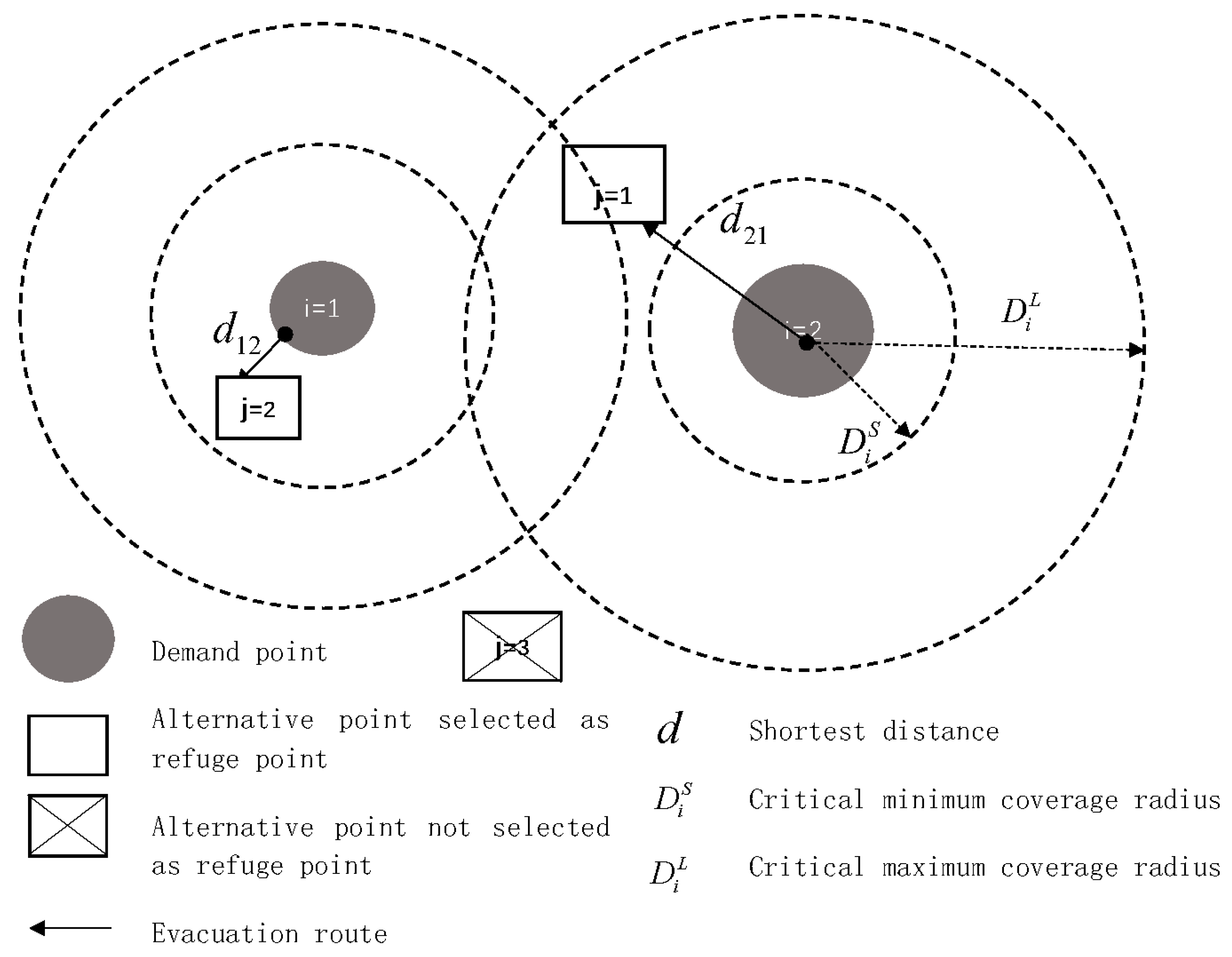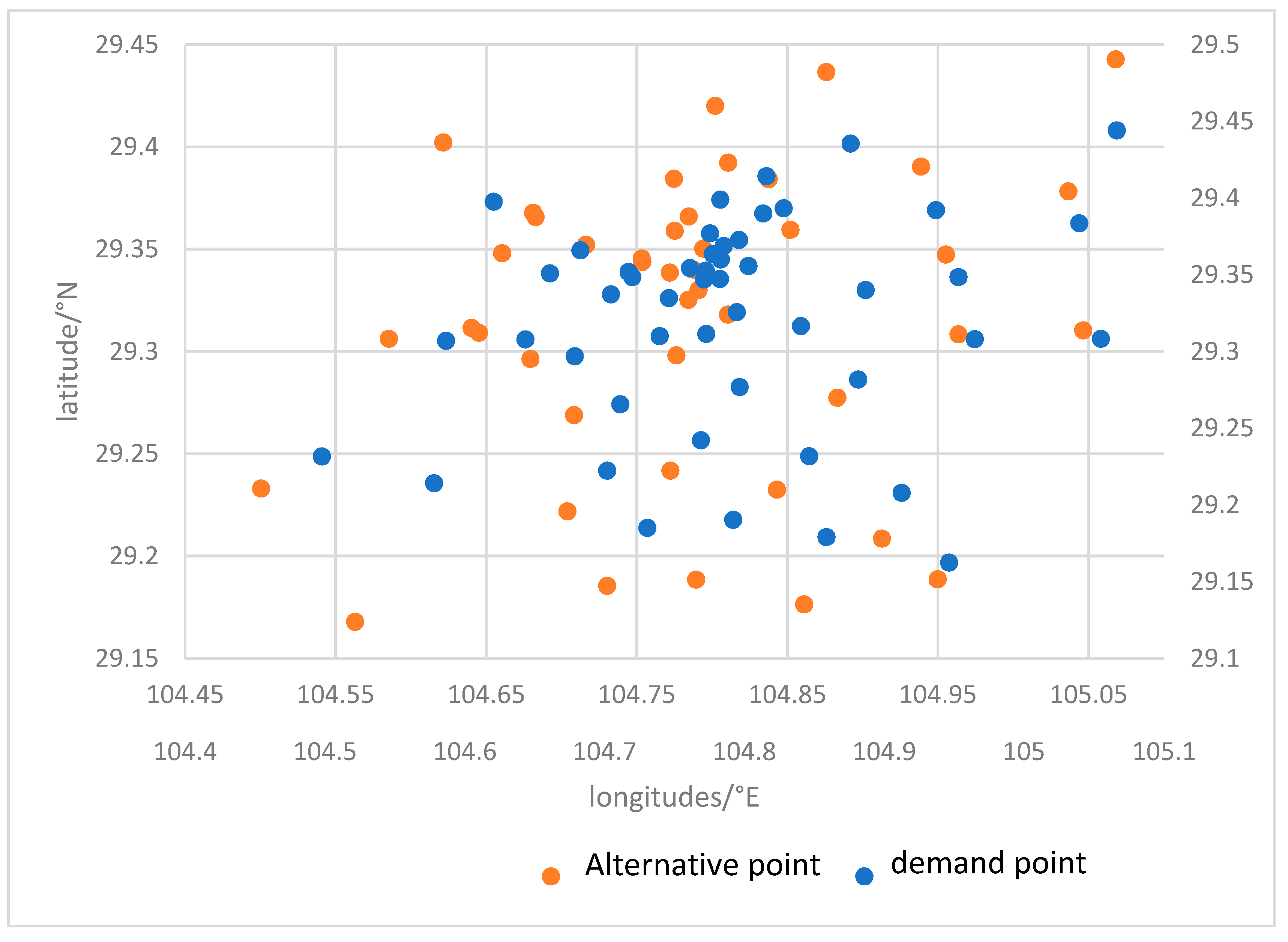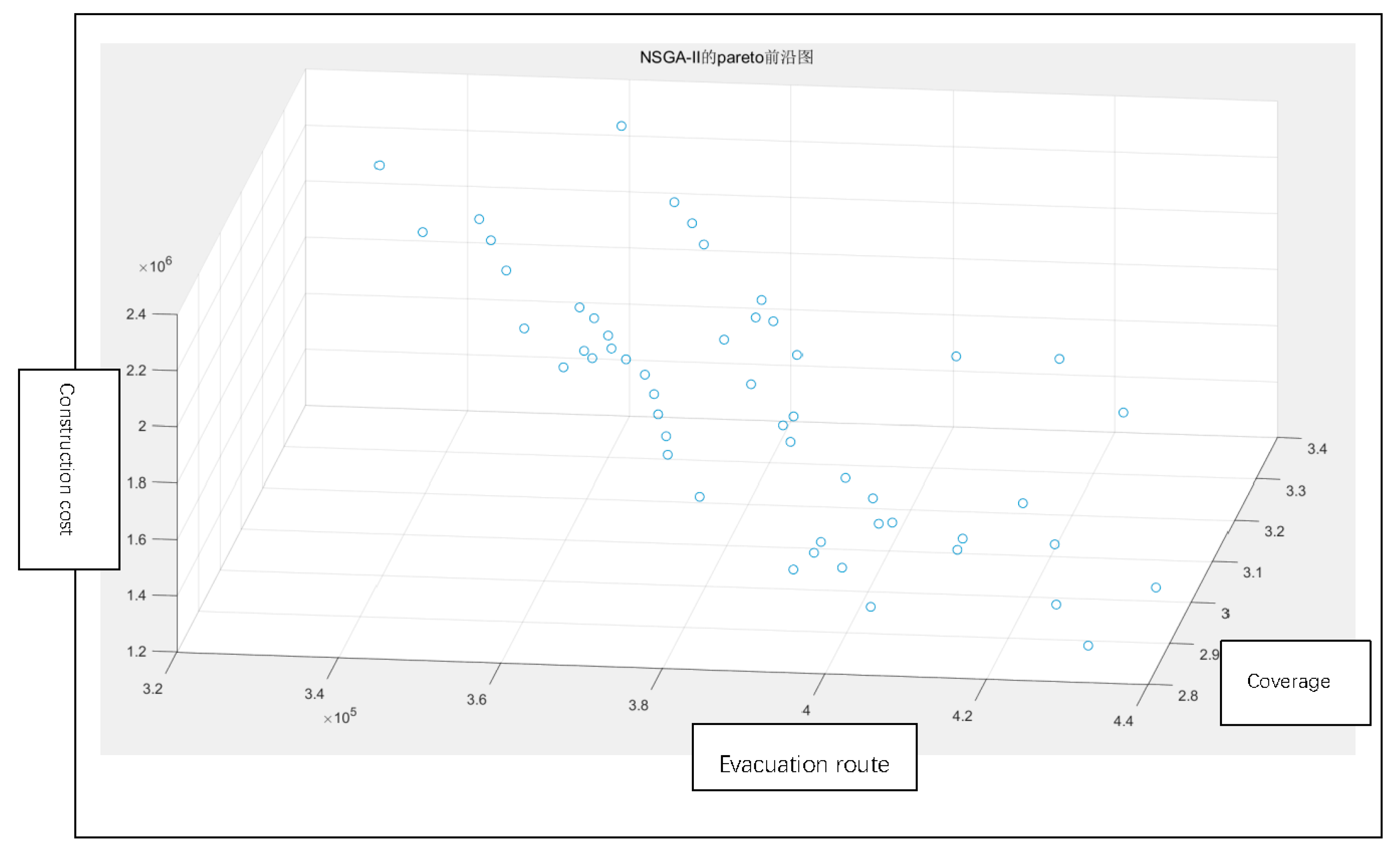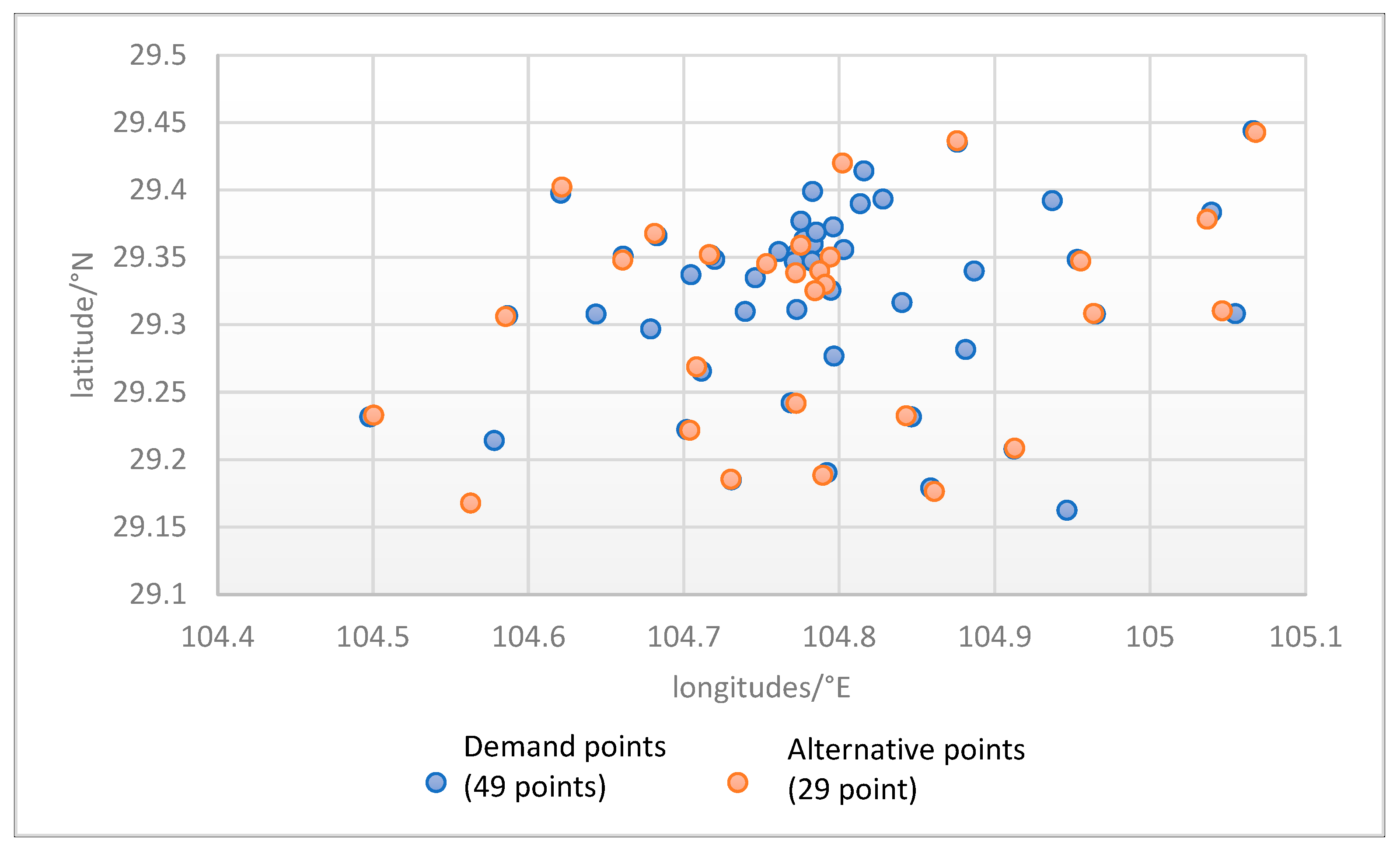Submitted:
15 July 2024
Posted:
16 July 2024
You are already at the latest version
Abstract
Keywords:
1. Background
2. Assessment of Social Vulnerability to Natural Disasters
2.1. Construction of Assessment System on Social Vulnerability for Natural Disasters
2.2. Assessment Model of Social Vulnerability to Natural Disasters
3. Vulnerability Index-Based Model for Siting of Central Shelters
3.1. Problem Description and Assumptions
3.2. Description of Symbols
3.3. Siting Model for Centers of Refuge Based on Vulnerability Index
4. Application of Site Selection Model
4.1. Overview of the Study Area
4.2. Evaluation of Social Vulnerability to Natural Disasters
4.3. Demand Points and Refuge Requirements
4.4. Model Solving
5. Conclusion
References
- Lv, W.; Han, Y.F.; Zhou, W.N.; et al. Study on the spatial correlation between the suitability evaluation of emergency shelters and the service scope. Journal of Safety and Environment 2023, 23, 694–703. [Google Scholar] [CrossRef]
- Zhao, L.J.; Li, H.Y.; Sun, Y.; et al. Planning Emergency Shelters for Urban Disaster Resilience: An Integrated Location-Allocation Modeling Approach. Sustainability 2017, 9, 2098. [Google Scholar] [CrossRef]
- Chen, G.; Fu, J.Y.; He, M.L. Emergency Shelter Location Problem Considering Residents' Choice Behavior. Operations Research and Management Science 2019, 28, 6–14. [Google Scholar] [CrossRef]
- Zhang, X.F.; Yu, S.C.; Zhang, X.F. Optimized Location Model of Resident Emergency Congregate Shelter Based on Multi-objective. Urban Development Studies 2020, 27, 59–66. [Google Scholar] [CrossRef]
- Ma, Y.J.; Zhao, X.J.; Qin, L.J.; et al. Multi-objective Location-allocation Model for Earthquake Emergency Shelters with Multiple Constraints: A Case Study in Wenchang of Hainan Province. Journal of Catastrophology 2018, 33, 218–224. [Google Scholar] [CrossRef]
- Zhao, J.J.; Guo, H.X.; Li, J.L.; et al. Two-stage Site Layout of Landslide Disaster Emergency Shelter. Systems Engineering 2022, 40, 140–149. [Google Scholar]
- Shi, Y.J.; Zhai, G.F.; Xu, L.H.; et al. Planning Emergency Shelters for Urban Disasters: A Multi-Level Location-Allocation Modeling Approach. Sustainability, 2019, 11.
- He, X.Z.; Zheng, H.; Peeta, S.; et al. Network Design Model to Integrate Shelter Assignment with Contraflow Operations in Emergency Evacuation Planning. Networks & Spatial Economics 2018, 18, 1027–1050. [Google Scholar]
- Yin, Y.; Zhao, X.C.; Lv, W. Emergency Shelter Allocation Planning Technology for Large-Scale Evacuation Based on Quantum Genetic Algorithm. Frontiers in Public Health, 2023, 10.
- Hansuwa, S.; Mohan, U.; Ganesan, V.K. Shelter Location-Allocation Problem with Vulnerabilities of Network and Disruption of Shelter During the Response Phase of Disaster[C]. In: Dolgui A, Bernard A, Lemoine D, von Cieminski G, Romero D, eds. IFIP Advances in Information and Communication Technology. Cham: Springer, 2021.705-713.
- Song, Y.H.; Gao, X.Q.; Huo, F.Z.; et al. Study on site selection of urban emergency shelters consider risk of flood disaster. Journal of Safety Science and Technology 2022, 18, 31–37. [Google Scholar] [CrossRef]
- Sritart, H.; Miyazaki, H.; Kanbara, S.; et al. Methodology and Application of Spatial Vulnerability Assessment for Evacuation Shelters in Disaster Planning. Sustainability 2020, 12, 7355. [Google Scholar] [CrossRef]
- Zhou, Y.; Li, N.; Wu, W.X. Research progress on social vulnerability to natural disasters. Journal of Catastrophology 2014, 29, 128–135. [Google Scholar]
- Cutter, S.L.; Finch, C. Temporal and Spatial Changes in Social Vulnerability to Natural Hazards. Proceedings of the National Academy of Sciences of the United States of America 2008, 105, 2301–2306. [Google Scholar] [CrossRef] [PubMed]
- Liu, Z.G.; Cai, F. Research on the evaluation index system of regional water ecological carrying capacity. Environmental Pollution & Control 2012, 34, 73–77. [Google Scholar] [CrossRef]
- Cutter, S.L.; Boruff, B.J.; Shirley, W.L. Social Vulnerability to Environmental Hazards. Social Science Quarterly 2003, 84, 242–261. [Google Scholar] [CrossRef]
- He, S.; Yang, S.N.; Li, S.S.; et al. Progress in Research on Social Vulnerability of Natural Disaster. Journal of Catastrophology 2014, 29, 168–173. [Google Scholar]
- Gong, Y.B.; Dai, L.L.; Yang, S.X. Study on the social vulnerability assessment of agricultural drought in Yunnan Province. Journal of Water Resources and Water Engineering 2017, 28, 239–243. [Google Scholar] [CrossRef]
- Chen, X.X.; Wang, P.M.; Fu, Z.G. Study on layout optimization of fixed refuge in mountainous city based on disaster risk assessment - Take Dongchuan district for example. Journal of Natural Disasters 2020, 29, 162–174. [Google Scholar] [CrossRef]
- Zhang, Y.; Wei, H.B. Combination weighting method for multi-attribute decision-making based on CRITIC. Statistics & Decision, 2012, 75-77. [CrossRef]
- Zhao, H.D.; Guan, S.X.; Bao, Y.E. Interval multi-attribute decision-making method based on combined weighting. Statistics & Decision, 2012, 98-101. [CrossRef]
- Li, W.J.; Zhai, G.F.; Chen, W. A review of shelter location based on multi-objective constraints. Urban Problems, 2021, 107-114. [CrossRef]
- Shi Y J, Zhai G F, Xu L H.; et al. Planning Emergency Shelters for Urban Disasters: A Multi-Level Location-Allocation Modeling Approach. 2019.
- Doerner, K.F.; Gutjahr, W.J.; Nolz, P.C. Multi-criteria Location Planning for Public Facilities in Tsunami-prone Coastal Areas. Or Spectrum 2009, 31, 651–678. [Google Scholar] [CrossRef]
- Zhao, Q.; Bai, Q.J.; Nie, K.K.; et al. Multi-objective optimization allocation of regional water resources based on NSGA-III algorithm and TOPSlS decision. Journal of Drainage and Irrigation Machinery Engineering 2022, 40, 1233–1240. [Google Scholar]




| Target layer | Criterion layer | Index layer | property |
|---|---|---|---|
| Reaction ability | infrastructure | C1 Road density | positive |
| C2 Average number of beds in health facilities per 10,000 people | positive | ||
| C3 Mobile phone penetration rate | positive | ||
| economic characteristic | C4 GDP per citizen | positive | |
| C5 Disposable income per citizen of urban and rural residents | positive | ||
| Social popularity | C6 Proportion of population with tertiary education level or above | positive | |
| ecological environment | C7 Natural disaster prevention and control investment density | positive | |
| sensitivity | Social popularity | S1 Population density | positive |
| S2 Ratio of population under 15 and over 65 years old | positive | ||
| S3 Ratio of population below the minimum subsistence level | positive | ||
| ecological environment | S4 Forest cover ratio | negative | |
| S5 Cultivated land area per citizen | positive |
| Target layer | Criterion layer | Unit | Gongjing district | Ziliujing district | Daan district | Yantan district | Rong county | Fushun county |
|---|---|---|---|---|---|---|---|---|
| response capability | C1 Road density | Kilometers/square kilometers | 2.18 | 2.31 | 2.67 | 2.50 | 1.81 | 2.40 |
| C2 Average number of beds in health facilities per 10,000 persons | Sheets per 10,000 persons | 243.92 | 94.95 | 110.66 | 45.00 | 79.14 | 70.38 | |
| C3 Cell phone penetration rate | ministry /Hundred Households | 280 | 243 | 237 | 271 | 247 | 235 | |
| C4 GDP per person | Yuan per person | 70483 | 82724 | 63808 | 85289 | 54996 | 49722 | |
| C5 Per citizen disposable income of urban and rural residents | Yuan per person | 3.12 | 4.21 | 3.13 | 2.84 | 2.78 | 2.28 | |
| C6 Proportion of population with post-secondary education | % | 7 | 23 | 6 | 8 | 6 | 6 | |
| C7 Investment intensity in natural disaster prevention and control | Million yuan/ square kilometers | 1.81 | 10.25 | 1.81 | 1.70 | 1.73 | 1.78 | |
| sensitivity | S1 population density | Personsper square kilometer | 680 | 2451 | 1016 | 837 | 408 | 787 |
| S2 Ratio of population under 15 and over 65 | % | 38 | 31 | 37 | 37 | 40 | 40 | |
| S3 Percentage of population below the minimum subsistence level | % | 6 | 2 | 5 | 5 | 10 | 8 | |
| S4 forest cover rate | % | 32.42 | 36.23 | 24.87 | 22.25 | 43 | 32.08 | |
| S5 Cultivated land area per person | Acreage per person | 2.78 | 0.67 | 0.63 | 0.69 | 1.70 | 2.30 | |
| Response capacity indicators | C1 | C2 | C3 | C4 | C5 | C6 | C7 |
| Weighting | 0.14 | 0.2 | 0.13 | 0.09 | 0.09 | 0.12 | 0.23 |
| Sensitivity Indicators | S1 | S2 | S3 | S4 | S5 | ||
| Weights | 0.24 | 0.19 | 0.23 | 0.18 | 0.15 |
| counties and cities | Fushun county | Rong county | Daan district | Yantan district | Gongjing district | Ziliujing district |
| 4.77 | 4.55 | 1.52 | 1.30 | 1.09 | 0.45 | |
| Average | 2.28 | |||||
| variance | 3.53 | |||||
| standard deviation | 1.88 | |||||
| categories | district |
| Heavy vulnerability | Fushun county Rong county |
| Moderate vulnerability | Daan district |
| Slight vulnerability | Yantan district Gongjing district Ziliujing district |
| /km | |||||||||||
|---|---|---|---|---|---|---|---|---|---|---|---|
| 1 | 2 | 3 | 4 | 5 | 6 | 7 | 8 | 9 | 10 | ||
| Alternative points | 14 | 6.0 | 5.4 | 5.3 | 6.3 | 4.2 | 5.0 | 6.9 | 1.8 | 3.7 | 11.2 |
| 15 | 9.2 | 9.8 | 8.8 | 7.7 | 9.9 | 8.8 | 8.3 | 11.7 | 10.6 | 11.5 | |
| 16 | 9.3 | 9.9 | 9.0 | 7.9 | 10.1 | 9.0 | 8.6 | 12.0 | 10.9 | 11.7 | |
| 17 | 11.4 | 12.0 | 10.9 | 9.8 | 11.8 | 10.7 | 8.7 | 13.2 | 11.6 | 10.4 | |
| 18 | 19.7 | 20.1 | 18.9 | 17.9 | 19.6 | 18.6 | 15.0 | 20.4 | 18.2 | 13.0 | |
| 19 | 14.2 | 14.5 | 13.3 | 12.3 | 14.0 | 12.9 | 9.2 | 14.6 | 12.4 | 8.0 | |
| 20 | 14.5 | 14.9 | 13.6 | 12.6 | 14.3 | 13.3 | 9.6 | 15.0 | 12.8 | 8.6 | |
| 21 | 30.5 | 30.8 | 29.5 | 28.7 | 30.2 | 29.1 | 24.7 | 30.3 | 27.8 | 20.8 | |
| Selected alternative points | Corresponding coverage demand points | Number of settlements covered/population | Evacuation capacity / 10,000 |
|---|---|---|---|
| 1 | 1,2,5,25 | 4 | 2.00 |
| 2 | 23,24,26 | 3 | 1.27 |
| 3 | 6 | 1 | 1.11 |
| 4 | 4,27 | 2 | 2.32 |
| 5 | 9,38 | 2 | 1.11 |
| 6 | 13 | 1 | 1.11 |
| 11 | 3 | 1 | 1.66 |
| 12 | 8 | 1 | 3.11 |
| 16 | 7,15,16 | 3 | 1.11 |
| 17 | 17,19 | 2 | 1.11 |
| 18 | 18 | 1 | 1.11 |
| 21 | 20 | 1 | 1.11 |
| 22 | 21 | 1 | 1.11 |
| 23 | 22 | 1 | 1.11 |
| 24 | 10,11 | 2 | 1.11 |
| 25 | 12,42 | 2 | 1.11 |
| 29 | 29,30,34 | 3 | 1.35 |
| 30 | 31 | 1 | 1.11 |
| 32 | 32,33,48 | 3 | 1.11 |
| 34 | 35 | 1 | 1.11 |
| 35 | 36 | 1 | 1.11 |
| 36 | 37 | 1 | 1.11 |
| 39 | 40 | 1 | 1.11 |
| 40 | 41,43 | 2 | 1.11 |
| 41 | 44 | 1 | 1.11 |
| 42 | 39,45 | 2 | 1.11 |
| 43 | 46 | 1 | 1.11 |
| 44 | 47 | 1 | 1.11 |
| 45 | 49 | 1 | 1.11 |
| aggregate line | 29 places of refuge | 49 demand points | 372,600 people |
Disclaimer/Publisher’s Note: The statements, opinions and data contained in all publications are solely those of the individual author(s) and contributor(s) and not of MDPI and/or the editor(s). MDPI and/or the editor(s) disclaim responsibility for any injury to people or property resulting from any ideas, methods, instructions or products referred to in the content. |
© 2024 by the authors. Licensee MDPI, Basel, Switzerland. This article is an open access article distributed under the terms and conditions of the Creative Commons Attribution (CC BY) license (https://creativecommons.org/licenses/by/4.0/).





